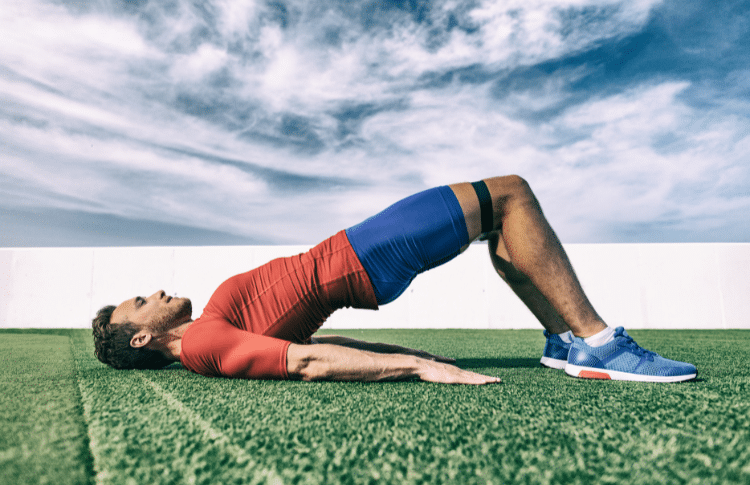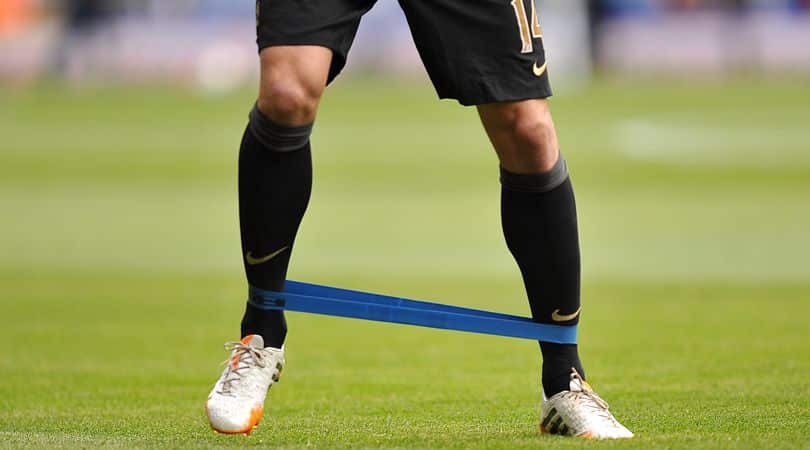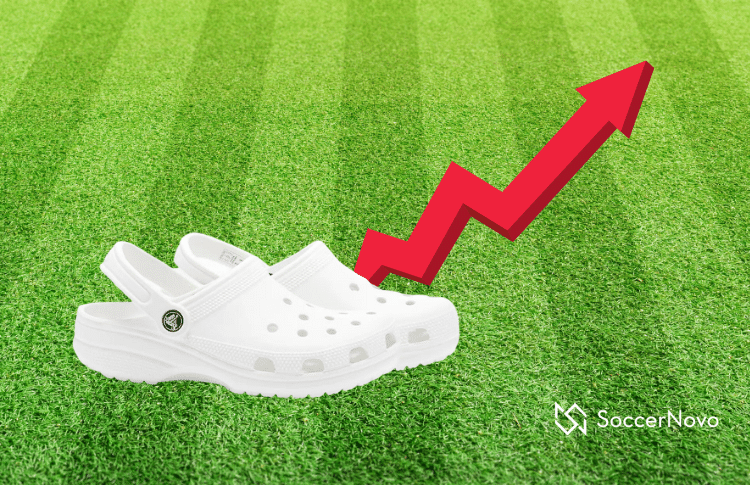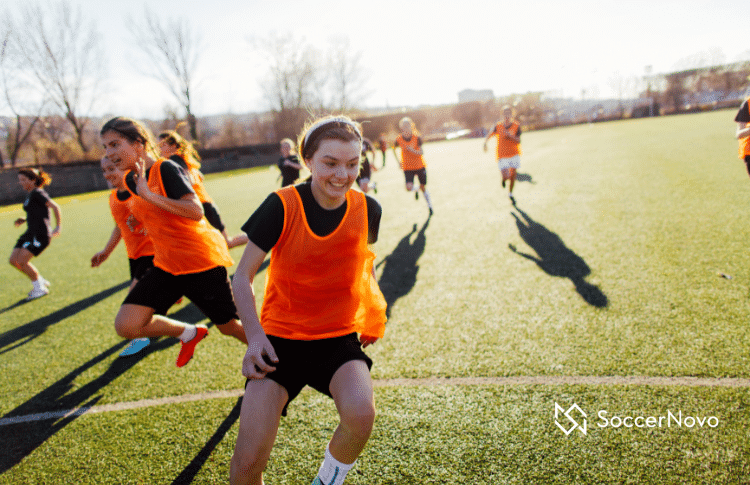Resistance Bands for Soccer

Resistance bands have become increasingly popular in soccer training and conditioning. You can use these bands on the field or at home during your weekly routine.
Resistance bands for soccer players are versatile and affordable that can help athletes of all levels improve their strength, speed, and agility.
With the help of resistance bands, soccer players can target specific muscle groups and movements that are essential for success on the field.
Whether you’re a youth player or a seasoned pro, incorporating resistance band exercises into your routine can help improve your game and maximize your potential as a soccer player!
In this article, we’ll explore the benefits of resistance band training, types of training and bands, and some tips on using them. Let’s go right into the program!
Understanding Resistance Bands
One of the main benefits of using resistance bands is that they allow soccer players to perform a wide range of exercises that target specific muscle groups. Resistance bands can be used for stretching and mobility exercises, warm-ups and muscle activation, resistance training, and developing the mind-muscle connection.

Soccer players can use resistance bands to target specific muscle groups that are used during soccer movements such as kicking, jumping, and running. The bands can be used to add resistance to exercises such as squats, lunges, and leg extensions, which can help build strength and power in the legs.
Resistance bands are also lightweight and portable, which makes them a convenient training tool for soccer players who are always on the go. They can be easily packed in a gym bag or suitcase and used anywhere, whether at home, in the gym, or on the field.
When choosing resistance bands, it’s important to select the right size and strength for the exercises being performed. Soccer players should choose bands that provide enough resistance to challenge their muscles but are not too difficult to use. It’s also important to use proper form when using resistance bands to avoid injury and maximize the benefits of the exercises.
How to Use Resistance Bands for Soccer Training
What’s the point of resistance bands if you don’t know what you are doing? For this reason, here are some videos on band training for soccer players.
Importance of Resistance Bands in Soccer
Here are some reasons why resistance bands are crucial for soccer players:
Injury Prevention
Soccer is a physically demanding sport that requires strength, agility, and endurance. Resistance bands can help players prevent injuries by strengthening the muscles and joints that are most commonly used during a game. They can also help players recover from injuries by providing low-impact resistance training.
Improved Flexibility
Flexibility is essential for soccer players to perform at their best. Resistance bands can help players improve their flexibility by providing resistance during stretching exercises. This resistance can help players increase their range of motion and prevent muscle imbalances.
Increased Strength
Resistance bands are an effective way to build strength without using heavy weights. They allow players to target specific muscle groups and perform exercises that mimic the movements used during a game. This can help players improve their speed, power, and endurance on the field.
Convenient and Portable
Resistance bands are lightweight and portable, making them an ideal tool for soccer players who want to train at home or on the field. They can be easily stored in a gym bag or suitcase and used in a variety of settings, including on the field, in the gym, or at home.
Types of Resistance Bands for Soccer
There are several types of resistance bands available, each with its unique features and benefits.
In this section, we will discuss the three most common types of resistance bands used in soccer training: loop bands, tube bands, and therapy bands.
Loop Bands
Loop bands, also known as mini bands, are small, flat, and circular bands that are perfect for lower body exercises. They are made of a stretchy material that provides resistance when stretched. Loop bands are available in different resistance levels, and soccer players can choose the one that suits their fitness level.
Loop bands can be used for exercises such as lateral walks, squats, lunges, and leg extensions. They are also useful for activating the glutes, which are essential muscles for soccer players.
Tube Bands
Tube bands, also known as resistance bands with handles, are long, cylindrical bands with handles on each end. They are versatile and can be used for upper and lower body exercises. Tube bands are available in different resistance levels, and soccer players can choose the one that suits their fitness level.
Tube bands can be used for exercises such as bicep curls, tricep extensions, shoulder presses, and chest presses. They are also useful for lower body exercises such as leg curls, leg extensions, and squats.
Therapy Bands
Therapy bands, also known as flat bands, are long and flat resistance bands that are perfect for upper body exercises. They are available in different resistance levels, and soccer players can choose the one that suits their fitness level.
Therapy bands can be used for exercises such as rows, pull-aparts, and chest flies. They are also useful for stretching and mobility exercises.
Choosing the Right Resistance Bands
When it comes to choosing the right resistance bands for soccer, there are a few factors to consider. The material, resistance level, size, and length of the band can all affect its effectiveness for soccer training.
Material
Resistance bands can be made from different materials, including latex, rubber, and fabric. Latex and rubber bands are the most common and are known for their durability and elasticity. However, some players may have a latex allergy, so fabric bands can be a good alternative. Fabric bands are also more comfortable to wear and can be easier to clean.
Resistance Level
Resistance bands come in different levels of resistance, ranging from light to heavy. Light resistance bands are best for beginners or players who are recovering from an injury. Medium resistance bands are suitable for intermediate players who want to improve their skills and strength. Heavy resistance bands are ideal for advanced players who want to challenge themselves and increase their power and speed.
Size
The size of the resistance band can affect its versatility and ease of use. Thinner bands are more suitable for upper body exercises, while thicker bands can be used for lower body exercises.
However, thicker bands may be more challenging to use for some players, especially those who are just starting out.
Length
The length of the resistance band can also affect its effectiveness for soccer training. Longer bands can be used for full-body exercises and stretching, while shorter bands are more suitable for targeted exercises. It’s important to choose a band that is long enough to perform the desired exercise without causing discomfort or strain.
Safety Tips for Using Resistance Bands in Soccer
Resistance bands can be a valuable tool for soccer players looking to improve their strength, speed, and agility. However, it’s important to use them safely to avoid injury. Here are some safety tips for soccer players:
- Inspect the bands before use: Before using a resistance band, it’s important to inspect it for any signs of wear and tear. Look for cuts, nicks, scratches, cracks, punctures, discoloration, or anything that looks like the band may be weakened in that area. If any flaws are discovered, discard the band immediately or exchange it for a new set.
- Use the bands for their intended purpose: Resistance bands should only be used for the specific exercises they were designed for and not as toys. Don’t try to whip your younger sibling with them 😉
- Start with low resistance: When beginning to use resistance bands, start with a low resistance level and gradually increase it as your strength improves. This will help prevent injury and ensure that you are using the bands safely and effectively. Don’t go Hulk mode from the start.
- Use proper form: It’s important to use proper form when using resistance bands to avoid injury. Make sure you are using the correct technique for each exercise and that you are not jerking the band or releasing it while under tension.
- Avoid overstretching: Do not stretch a band over 2 ½ times its length. This can cause the band to snap and potentially cause injury.
By following these safety tips, soccer players can use resistance bands safely and effectively to improve their performance on the field.
Conclusion
Resistance bands are great for soccer players. Using them properly will help improve your strength, speed, agility, and overall performance on the field.
By incorporating resistance band exercises into your training regimen, you can target specific muscle groups and movements that are critical for success in soccer.
Research has shown that power-band resistance training can improve sprint speed, agility, and vertical jump height, as well as 1-repetition maximum (1RM) strength in soccer players.
Resistance bands can also be used for stretching and mobility, warm-ups and muscle activation, and developing the “mind-muscle” connection.
Phew, I hope this article helps you become more mobile, stronger, and faster on the field!

Written By: SoccerNovo
SoccerNovo is an independent youth soccer media brand built to help parents, players, and coaches better understand the game and the pathways available in U.S. soccer. Our mission is to make youth soccer simpler, clearer, and more accessible for everyone involved in it.
Let’s connect



